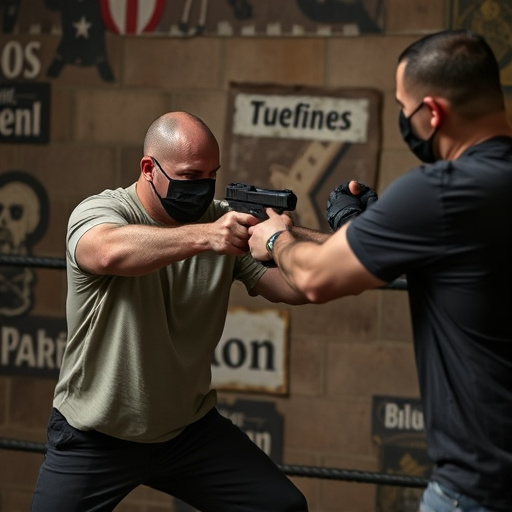Safeguarding against Accidental Discharge: Stun Gun Safety Guide
Accidental discharges from stun guns pose significant risks due to mechanical failures, user error,…….
Accidental discharges from stun guns pose significant risks due to mechanical failures, user error, and external stimuli, with incorrect handling being a common factor. To prevent these incidents, it's crucial to:
1. Properly charge stun guns using manufacturer-recommended chargers, inspecting for damage beforehand.
2. Follow safety guidelines meticulously, keeping charged devices away from hazards and children.
3. Maintain and store stun guns correctly by adhering to manufacturer instructions, storing them in secure cases, unloaded, and complying with local laws.
4. Regularly clean and store for optimal performance and reliability.
“Accidental discharge of stun guns can have severe consequences, highlighting the critical need for robust prevention mechanisms. This comprehensive guide explores the intricate world of stun gun safety, focusing on understanding common causes and associated risks. We delve into essential practices for responsible handling, ensuring users employ proper techniques when charging and deploying their devices. Additionally, we discuss best practices for maintenance and storage, emphasizing the importance of a secure environment to prevent unforeseen incidents.”
- Understanding Accidental Discharge: Causes and Risks
- Essential Safety Measures for Proper Stun Gun Handling
- Maintenance and Storage: Keeping Your Stun Gun Safe
Understanding Accidental Discharge: Causes and Risks

Accidental discharge, a significant concern in the operation of stun guns, can lead to severe consequences and unintended harm. Understanding the causes and risks associated with this phenomenon is paramount for ensuring safe usage. Stun guns, despite their design intent, can inadvertently fire due to various factors, including mechanical failures, user error, or external stimuli. One of the primary mechanisms involves incorrect handling, such as dropping the device or mishandling the trigger mechanism, especially given that stun guns operate on electricity and any short circuit can lead to unexpected activation.
Proper training and knowledge are essential to mitigating these risks. This includes learning how to charge a stun gun correctly, ensuring it remains secured when not in use, and understanding the device’s safety features. Users should also be aware of environmental factors that could act as triggers, like metal objects or certain fabrics, which might cause accidental discharge. By addressing these causes and adopting preventive measures, users can significantly reduce the likelihood of accidental discharges, enhancing both personal safety and the reliability of the stun gun as a self-defense tool.
Essential Safety Measures for Proper Stun Gun Handling

Proper handling of a stun gun involves several crucial safety measures that users should adhere to, especially during charging and deployment. To ensure optimal functionality and prevent accidental discharge, it’s essential to understand how to charge a stun gun correctly. Begin by inspecting the device for any visible signs of damage; if damaged, do not use until repaired or replaced. Only use the charger and cable provided by the manufacturer to avoid compatibility issues that could lead to improper charging.
Next, follow the instructions in the user manual carefully when plugging in and charging your stun gun. Make sure the device is switched off during charging. Never leave a charged stun gun unattended, especially near flammable materials or children. Regularly review safety guidelines to stay informed about best practices for stun gun handling, storage, and use.
Maintenance and Storage: Keeping Your Stun Gun Safe

Proper maintenance and storage are essential aspects of accidental discharge prevention for any stun gun owner. Regular cleaning and charging according to the manufacturer’s guidelines are crucial. Learn how to charge your stun gun properly, as incorrect charging can lead to malfunction or even cause safety risks. Always store your stun gun in a secure, dedicated case, keeping it away from children and unauthorized individuals. Ensure the device is unloaded when not in use, and consider storing it in a locked drawer or cabinet for added safety.
Additionally, familiarize yourself with local laws and regulations regarding stun gun ownership and storage to ensure compliance. By maintaining and storing your stun gun responsibly, you contribute to its longevity and reduce the risk of accidental discharge, making it a valuable tool when needed.
Accidental discharge of a stun gun can be avoided by understanding its causes, implementing proper handling practices, and ensuring safe maintenance and storage. By following essential safety measures, such as secure storage, regular inspection, and learning the device’s operation, users can minimize risks associated with stun guns. Proper charging of the stun gun according to manufacturer guidelines is crucial, ensuring it’s always ready when needed. With these precautions, individuals can confidently carry and use their stun guns while prioritizing safety.


